Physical Address
304 North Cardinal St.
Dorchester Center, MA 02124
Traumatic forces applied to an immature knee result in fracture patterns that differ from those seen in adults. As in other anatomic regions in a growing child, the cartilaginous structures around the knee are weaker than the ligaments and tendons that insert onto them, making them more vulnerable to injury. Fractures involving the epiphyses require accurate reduction to minimize the risk of growth disturbances that could lead to significant angular deformity or leg length discrepancy. As in adults, fractures involving the articular surfaces require meticulous reduction to restore joint congruity to best assure long-term functionality. As the knee matures into adolescence, adult-type cartilaginous and ligamentous injuries become more prevalent and should be considered when evaluating injuries in this population.
Although the total reported incidence of supracondylar femur fractures account for 12% of all femoral fractures in children, the incidence of displaced fractures in otherwise healthy children is significantly smaller. These fractures only account for 3% of all pediatric femur fractures.
In managing distal femoral metaphyseal fractures, it is important to remain cognizant of a few key neurovascular structures positioned in close proximity to the distal end of the femur, namely the femoral/popliteal artery and the peroneal and tibial nerves. This anatomy becomes more important when considering percutaneous fixation in this region. The femoral artery runs through the adductor canal, where it is in close proximity to the medial cortex of the distal femur as it descends and enters the posterior compartment. It becomes the popliteal artery as it emerges from the adductor hiatus and enters the popliteal fossa more distally. As the popliteal artery enters the popliteal fossa (sometimes referred to as the popliteal space), only a thin layer of fat separates the artery from the posterior surface of the femoral metaphysis. As the artery is relatively tethered proximally to the femur at the adductor hiatus and distally to the fibrous arch over the soleus muscle, it is vulnerable to injury from the metaphyseal spike that occurs with a supracondylar femur fracture. Within the popliteal fossa, five geniculate arteries originate from the popliteal artery: paired superior and inferior branches and an unpaired middle geniculate. Although these arteries anastomose with the anterior tibial recurrent artery, they are diminutive and cannot provide sufficient blood supply to the lower part of the leg if the popliteal artery is occluded or disrupted.
The tibial nerve lies adjacent to the popliteal artery in the popliteal fossa, descending into the posterior compartment of the leg. The common peroneal nerve branches from the sciatic nerve, more proximally, above the popliteal fossa and descends along the lateral border of the fossa adjacent to the medial border of the biceps femoris muscle. The nerve descends distally between the biceps femoris muscle and the lateral head of the gastrocnemius, becoming subcutaneous behind the fibular head. It then wraps around the neck of the fibula, deep to the peroneus longus muscle. Because of its location and proximal and distal tethering, the common peroneal nerve can be injured by a displaced distal femoral fracture, much like the popliteal artery, especially when the injury results from hyperextension and/or varus stress. This structure is also specifically at risk with proximal tibial traction pin insertion.
Distal femoral metaphyseal fractures most often result from a direct blow to the anterior or lateral aspect of the thigh or a fall from height, resulting, most commonly, in a transverse fracture pattern. In children younger than 4 years of age, especially in nonambulatory children, nonaccidental trauma should be considered. The lack of a reasonable explanation, an unreasonable delay in seeking medical care, and/or the presence of concomitant injuries should raise the level of suspicion for a nonaccidental cause. Specifically, corner fractures, or bucket-handle lesions, at the level of the distal metaphysis are pathognomonic for nonaccidental trauma—these occur almost always in children less than 12 months of age. However, other fracture patterns have been associated with child abuse as well. In fact, Arkader published a series of complete transverse distal femoral metaphyseal fractures, in which 20 of 29 fractures were in children less than 1 year of age. Of those 20, 75% were associated with or were highly suspicious for child abuse.
In older children, nondisplaced fractures and stress fractures may occur as an overuse injury. These patients present with local pain and tenderness, and radiographs typically reveal robust periosteal bone reaction. Pathologic fracture should be considered in these patients. Distal femoral metaphyseal fractures have also been reported in association with certain musculoskeletal conditions, including osteogenesis imperfecta, spina bifida, spinal muscular atrophy, and hemophilia.
Patients with a fracture of the distal femoral metaphysis present with local soft tissue swelling, tenderness, and deformity at the distal thigh and knee. The skin must be inspected for a possible open fracture. Because of the neurovascular anatomy previously described, a careful neurovascular examination is mandatory.
The presence and strength of a pedal pulse should be documented. The use of a Doppler ultrasound may aid in assessing the circulation to the limb if pulses are not palpable. An assessment of the ankle-brachial index (ABI) should be considered in any patients with a clinical examination concerning for vascular injury. If the limb is ischemic, a gentle reduction maneuver may restore circulation. Absent or diminished pulses may warrant vascular imaging. However, if the limb is frankly ischemic and the location of the vascular injury is clear, vascular exploration and early restoration of perfusion should not be delayed for imaging.
The function of the common peroneal and tibial nerves should additionally be tested and documented at initial evaluation. The peroneal nerve is tested with ankle dorsiflexion and great toe extension; the tibial nerve is tested with plantar flexion. The peroneal nerve is specifically at risk with either a direct blow to the posterolateral corner of the knee (e.g., from a car bumper) or from a stretch injury at the time of greatest displacement.
Ongoing serial evaluation of the lower extremity is important during the first few days after presentation so that a developing compartment syndrome may be detected promptly. This examination includes a neurological and a vascular examination. Compartment pressures should be measured if clinical signs and symptoms of a compartment syndrome are noted.
Anteroposterior (AP) and lateral radiographs of the distal end of the femur should be ordered and evaluated. As with any long bone fracture, radiographs of the entire bone should be taken, necessarily including the joint above and below the injury. Accordingly, radiographs of the entire femur, including the hip and knee, should be obtained at initial evaluation. These fractures, in general, do not require advanced imaging modalities, with the exception of vascular imaging for ischemic limbs.
Fractures of the distal femoral metaphysis in children are classified descriptively by the fracture pattern (transverse, oblique), the degree of displacement, and the presence or absence of comminution.
If the limb is ischemic, a gentle reduction may restore circulation, as was mentioned in “Evaluation.” The injured extremity should be splinted in a position of comfort after initial evaluation. Traction, either skin or skeletal, may be useful in multiply injured patients or medically compromised patients when definitive management will be delayed. The neurovascular status should be serially monitored pending definitive management of the fracture. This may include serial ABIs if vascular injury is suspected.
Given the nature of the deforming forces on this fracture, the significant risk for displacement, and the burden of nonoperative treatment in these fractures, nonoperative treatment is rarely recommended. Nonoperative treatment may be appropriate for truly nondisplaced fractures. Although a single-leg spica cast provides the most secure immobilization, especially in more obese children, a long leg cast may suffice for very distal fractures. This decision should be made by the treating physician, based on his/her judgement of fracture location and stability. Fractures treated in this manner must be closely followed, as the risk of subsequent displacement is present.
Traction and cast application is less commonly used as definitive treatment currently as compared with previous generations. This technique has been largely replaced by operative management, given the overall burden that both traction and casting introduce to the hospital system, the patient, and the patient’s family. However, the technique of balanced traction described below may be useful for temporary immobilization in the polytraumatized patient to maintain length and alignment of the fracture while definitive management is provided. Casting following traction may be used in patients who cannot tolerate surgical management for any reason.
In this technique, traction is applied to the lower extremity, maintaining proper reduction of the fracture until enough callus has formed to be safely maintained in a spica cast or long leg cast. In a young child, skin traction can be applied to the lower part of the leg, but skeletal traction is preferable in children older than 3 years of age.
Skeletal traction with the use of a Steinmann pin may be applied through the distal end of the femur or the proximal tibia. Regardless of site chosen, the pin is applied aseptically under local or general anesthesia. For distal femoral traction, the pin should be inserted medial to lateral so that the risk of injury to the femoral artery in the region of the adductor canal is minimized. For proximal tibial traction, the pin should be inserted in a lateral-to-medial direction so that the risk of injury to the peroneal nerve is minimized. Care should also be taken to avoid the proximal tibial physis and tibial tubercle apophysis.
Because of the muscle forces that act on the fracture fragments in this fracture pattern, the use of a single-traction pin may not maintain adequate alignment. Double-pin traction is often required. A proximal tibial pin provides longitudinal traction, but an additional distal femoral pin inserted into the distal femoral fragment may be required to provide an anteriorly directed force to achieve satisfactory sagittal alignment. Similarly, if the distal femoral fragment is long enough, two pins may be inserted into the femoral fragment proximal to the physis to achieve the same desired result. Staheli described a double-pin traction technique in which one pin is placed through the metaphysis and a second pin is placed through the epiphysis. The two pins are attached to an external fixation apparatus through which traction is applied. The patient is then placed in 90/90 traction. Once early callus forms and sagittal plane alignment is satisfactory, the knee is straightened gradually, and traction can be removed if the sagittal alignment is maintained on radiographs. Any residual coronal malalignment can be corrected with cast placement while the callus is still relatively soft.
The duration of immobilization varies with the age of the patient—3 to 4 weeks in the very young and 6 to 8 weeks in older children, which is determined by radiographic signs of adequate healing. After removal of the cast, rehabilitation is required to strengthen the quadriceps and hamstring. Weight-bearing is as tolerated, but assistive devices—crutches or a walker—are used for mobilization until knee motion and thigh strength are adequate to allow for independent ambulation. Return to regular activities is permitted after the quadriceps has regained normal strength and full range of motion of the knee joint has been achieved.
This technique may be complicated by pressure ulcers from prolonged immobilization, varus malalignment, and premature closure of the anterior part of the proximal tibial physis with proximal tibial traction, which will result in a recurvatum deformity. Careful cast application and management can prevent coronal malalignment. Meticulous proximal tibial pin placement will help avoid injuring the physis and tibial tubercle apophysis, although there are reported cases of premature tibial tubercle arrest occurring in association with femoral fractures, in the absence of tibial traction. Malalignment in the sagittal plane may result in an apparent hyperextension or flexion deformity of the knee with associated limitations in range of motion. In a young child, this deformity largely remodels with time, as it is in the plane of motion of the knee.
Surgical treatment has largely replaced nonoperative management in these fractures and is indicated for essentially all displaced fractures of the distal metaphysis of the femur, as the muscle forces acting on the distal fragment make obtaining and maintaining proper alignment of displaced fractures difficult without internal or external fixation. Generally, the distal fragment displaces posteriorly, into recurvatum, because of the pull of the gastrocnemius. If the fracture line is just proximal to the distal insertion of the adductor magnus, the distal fragment may also angulate into a varus position. To counteract these muscular forces, surgical options include external fixation, closed or open reduction with percutaneous pin fixation followed by the application of a long leg cast, open reduction with internal fixation, and submuscular bridge plating.
External fixation is an effective tool used to reduce and stabilize distal femoral metaphyseal fractures ( Fig. 13.1 ). The best situations for the use of external fixation for this injury are in polytraumatized patients and those with an open fracture, an associated vascular injury, and/or a floating knee.
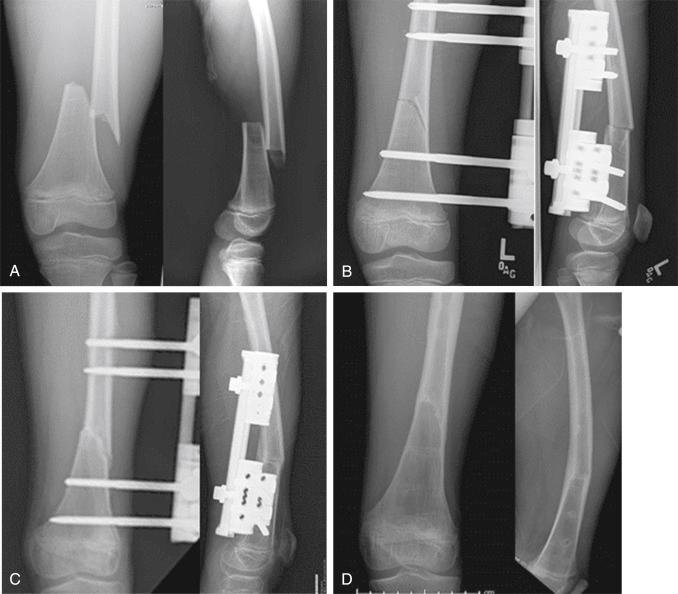
In cases of polytrauma with multiple fractures, abdominal injury, or head injury, stabilizing the fracture with an external fixator is quick and safe, allowing for other diagnostic studies and/or operative procedures. In persistently comatose children, external fixation provides stability of the fracture while introducing minimal surgical risks. Given the high rate (>90%) of neurologic recovery in children following traumatic brain injury, it is important to treat all fractures in children with head injuries with the assumption that full neurologic recovery will occur.
In addition to polytrauma stabilization, external fixation greatly facilitates wound care in open fractures. Further, stabilization of the distal part of the femur with an external fixator allows for easier care of concomitant injuries—vascular injury and/or an associated tibial fracture. Further, external fixation may limit the cost of prolonged hospitalization that occurs with the use of traction while providing more mechanical stability and decreasing the burden of care placed on the family.
In utilizing an external fixator to manage a distal femoral metaphyseal fracture, several technical points should be kept in mind. Pins should be inserted from lateral to medial under image intensifier control through uninjured skin, whenever possible. The distal pin(s) should be placed at least 1 cm (preferably 2 cm) proximal to the physis to avoid potential thermal injury during insertion, as well as injury from a possible pin tract infection. Once the pins are placed and the external fixator bar is connected, a reduction can be achieved with manual traction and knee flexion to counteract the forces of the gastrocnemius on the distal fragment. In transverse fractures, an end-to-end reduction is attempted; in oblique fractures, bayonet apposition with approximately 5 mm of overlap should be considered in children younger than 10 years to minimize the effect of limb overgrowth. After preliminary placement of the frame, final adjustments to coronal and axial alignment can be made under fluoroscopic guidance.
Pin care is taught to the caregiver while in the hospital, and the authors recommend that it should be continued daily. Typical pin care consists of daily cleaning with either normal saline– or hydrogen peroxide–soaked Q-tip or gauze. Some experts recommend only daily bathing and soap and water cleaning of external fixation pin sites. Partial weight-bearing with crutches can be initiated early. Once radiographs reveal callus formation, weight-bearing is progressed to full.
Once the fracture is healed clinically and radiographically (at least three cortices with bridging callus on AP and lateral views), typically occurring between 6 and 12 weeks from the time of the injury (depending on the age of the patient), the device may be removed in the outpatient setting. In most older children and all adolescents, it is best to leave the external fixator on for the full 12 weeks to minimize the risk of refracture after frame removal.
Potential complications include pin tract infection, malunion, refracture through either a pin tract or the original fracture site, and growth disturbances. Although not entirely preventable, the risk of pin tract infections is reduced with diligent pin care. If they do occur, pin tract infections should be treated with a short course (7–14 days) of oral antibiotics. However, if drainage persists or if erosion around the pin is apparent on radiographs, the pin should be exchanged and the original tract should be surgically débrided. Alternatively, if there is sufficient stability at the fracture site, the entire fixator can be removed and replaced with a cast until the fracture is fully healed.
Malunion can be prevented with placement of the fixator, paying specific attention to rotational and coronal reduction at the time of placement. Injury to the distal femoral physis is avoidable if the pins are placed at least 1 cm proximal to the physis. The pins should always be inserted under image intensifier control to avoid direct injury to the physis.
Refracture occurs more often with fractures treated with external fixation than with other methods. A fracture may occur through the initial fracture site if the frame is removed prematurely. A fracture may also occur through a pin site, particularly in young children in whom large 5-mm fixator pins have been used.
Closed reduction and percutaneous pin fixation supplemented by the application of a long leg cast is a commonly used treatment modality for supracondylar femur fractures. This technique is particularly useful in younger patients in whom the metaphyseal fracture is quite distal ( Fig. 13.2 ).
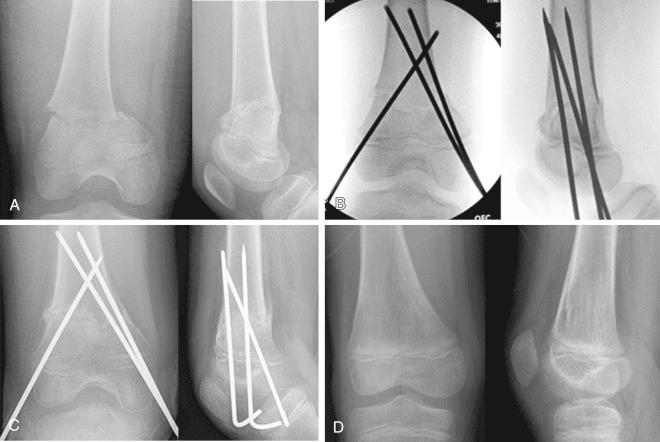
Under general anesthesia, the fracture is reduced typically with knee flexion and traction, and smooth pins are inserted in a retrograde crossed fashion under image intensifier control. It is preferable to insert the pins through the distal metaphysis, provided that sufficient metaphyseal length is available for placement. If there is not sufficient metaphysis distal to the fracture site for stable fixation, the pins may be inserted through the distal femoral epiphysis, crossing the physis, as described in detail for distal femoral physeal fractures. If so, smooth pins should be used. The pins are left percutaneously for ease of removal and bent at the skin to avoid proximal migration. A long leg cast is applied with the knee immobilized in 20 to 30 degrees of flexion. The pins can usually be removed after 4 weeks to decrease the risk of pin-site infection. The cast is then replaced, and after 6 to 8 weeks, immobilization is discontinued. Damage to the femoral vessels on the medial side has been suggested as a potential complication of this method. Butcher and Hoffman have recommended that the lateral pin(s) should be placed posteriorly and directed anteriorly so that damage to the femoral vessels near the adductor hiatus is avoided. Although smooth pins that transgress the growth plate carry a theoretical risk of potential growth disturbance, the small diameter of the pins relative to the physeal area makes this complication unlikely.
Alternatively, Parikh et al published a small series of supracondylar femur fractures that were fixated with elastic nails, which resulted in radiographic healing in all seven patients with adequate alignment and no major complications. When there is adequate metaphyseal bone stock for placement of elastic nails, this is a reasonable option, avoiding the need for obligatory supplemental casting.
Open reduction and internal fixation is also appropriate for fractures that are irreducible by closed means and/or in the setting of vascular injury. The most common reason for failure to obtain adequate closed reduction is the presence of interposed muscle between fracture fragments. If repair of an arterial injury is required, internal fixation prevents excessive motion at the fracture site and protects the repair.
The surgical approach depends on the indication for open surgery. If interposed muscle is blocking reduction, a direct lateral approach allows the quadriceps muscle to be reflected anteriorly and provides adequate access to the distal end of the femur for manual reduction. If arterial repair is required, the incision should be placed posteromedial to allow access to the femoral and popliteal arteries, as well as the saphenous vein, if vein grafting is necessary.
Rigid internal fixation, as is commonly used in adults, is not usually necessary in children. Percutaneous fixation can be successfully combined with open reduction. This technique allows for the required access for reduction or vascular exploration and is associated with excellent radiographic and clinical results in a small series of widely displaced pulseless fractures, drawing parallels to pulseless supracondylar humerus fracture management. As in closed reduction and percutaneous fixation, fixation should be supplemented with a long leg cast. Of note, in the setting of a vascular injury, an external fixator may be more appropriate stabilization. The fixation choice should be agreed upon in conjunction with the surgeon who is treating the vascular injury, if not the same surgeon treating the fracture.
Compression plate fixation is rarely indicated to treat distal femoral metaphyseal fractures in a growing child, except perhaps in older/larger children and in the polytrauma setting. In this situation, compression plating may be a useful alternative and does not cause excessive femoral overgrowth. The plate is generally removed 6 to 9 months following placement. Lateral plate fixation has been associated with the development of distal femoral valgus deformity in distal femoral shaft fractures. The etiology is not fully understood, and there is not a defined association between removal of hardware or retaining hardware and propensity to develop this deformity.
More recently, Lin and colleagues described open reduction and internal fixation utilizing a pediatric physeal slide traction plate for fixation of comminuted distal femur fractures in children. They reported excellent outcomes in 16 children treated with this device after a mean follow-up of 36 months. They recommended this device as a safe and effective treatment option for children with comminuted distal femur fractures. Other authors have advocated the use of proximal humerus plates for the fixation of these fractures, as they are appropriately sized for the distal femur in the pediatric population and provide locking fixation options. A number of plate design options are now available to maximize the possible number of screws in the distal metaphyseal segment.
Submuscular bridge plating is an alternative option for treating these fractures. This technique is especially advantageous for managing comminuted and unstable fracture patterns ( Fig. 13.3 ). The procedure is performed with the use of an image intensifier. A precontoured plate is tunneled proximally through a small distal incision deep to the vastus lateralis muscle. Reduction of the fracture is achieved manually, and the plate is secured to the femur with percutaneously placed screws proximal and distal to the fracture site. A plate with locking options should be used in fractures with limited bone stock available for fixation distally.
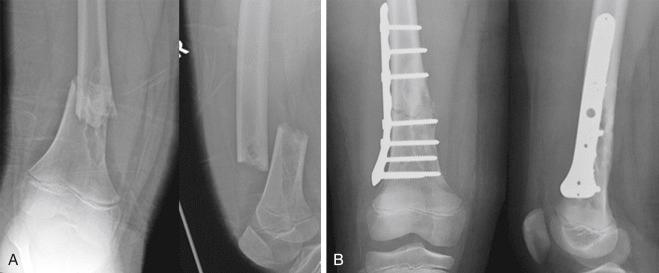
No immobilization is required postoperatively, and the patients are encouraged to begin immediate knee range of motion. Toe-touch weight-bearing is maintained until early callus is evident radiographically. The plate may be removed 6 to 9 months after fixation, as is the case with compression plating. Minimized soft tissue dissection used in this technique is believed to result in rapid fracture healing and faster return of function as compared with traditional open reduction and plate fixation.
In the absence of neurovascular complications, the outcome of fractures of the distal femoral metaphysis is excellent. Fractures in this region heal rapidly, and early return to full activities is the rule.
Malunion is a potential complication after the treatment of a distal femoral metaphyseal fracture. Sagittal plane deformity has a good capacity for remodeling, depending on the age of the patient. Coronal plane malunion has limited remodeling potential. Significant residual varus or valgus deformity may be addressed by guided growth or osteotomy, as can distal femoral valgus deformity associated with lateral plating.
Avoiding malunion requires knowledge of lower extremity anatomy and bony anatomic morphology. The anatomic axis of the shaft of the femur differs from the mechanical (weight-bearing) axis. The mechanical axis passes through the head of the femur and the middle of the knee joint and generally subtends an angle of 3 degrees from the vertical. The anatomic axis that runs through the shaft of the femur has an average valgus angulation of 6 degrees relative to the vertical axis. The knee joint line is typically parallel to the ground, and the anatomic femoral axis subtends an 81-degree lateral distal femoral angle relative to the knee joint. For each patient, it is important to confirm this angle by comparing it to the contralateral femur because individual variations do occur.
Fractures of the distal femoral physis account for 1.4% to 5.5% of all physeal injuries and slightly more than 1% of all pediatric fractures.
The distal femoral epiphyseal ossification center is present in a full-term newborn infant. With subsequent growth, this ossification center rapidly expands to fill both condylar regions. The distal femoral physis is the largest and most rapidly growing physis in the body. It contributes almost 70% of the growth of the femur and 40% of the longitudinal growth of the entire leg, averaging approximately 1 cm of growth yearly until maturity. Closure of this growth plate usually occurs between 14 and 16 years of age in girls and between 16 and 18 years in boys. Any injury that partially or completely disrupts growth of the distal end of the femur may lead to significant angular deformity or foreshortening of the extremity. The younger the patient is at the time of injury, the greater the potential for these sequelae.
The distal epiphysis includes the entire articular surface of the lower end of the femur and serves as the origin for part of the gastrocnemius muscle. Both the medial and lateral collateral ligaments originate from the distal femoral epiphysis. When a varus or valgus force is exerted on the knee, ligamentous injury is uncommon. Rather, the force most commonly dissipates through the distal femoral physis, resulting in a physeal fracture.
The configuration of the distal femoral physis is unique and has been well described by Roberts. The distal surface of the metaphysis consists of four gentle mounds, one in each quadrant of the cross-sectional area. These mounds fit into four shallow depressions on the proximal surface of the epiphysis. This complex anatomy has been well-demonstrated by three-dimensional magnetic resonance imaging (MRI) modeling. Although this undulating contour probably provides resistance to shear and torsional forces, it may also predispose regions of the epiphysis to grind against the metaphyseal projections when a separation occurs, resulting in germinal layer injury. This complex anatomy may help explain the frequency of growth disturbances following distal femoral physeal injury.
The relevant vascular anatomy has been outlined in the preceding section.
The majority of these fractures are sustained in pedestrian versus automobile accidents or are sports related. Riseborough and colleagues observed that fractures in the juvenile group—ages 2 to 11 years—were invariably caused by severe trauma (i.e., motor vehicle accident), whereas fractures in the adolescent age group were most often sports related.
Because the physis provides less resistance to traumatic forces than the attached ligaments, a varus or valgus stress applied to an immature knee more often results in physeal separation than in collateral ligament injury. If hyperextension of the knee occurs, the epiphysis may displace anteriorly. This mechanism of injury is similar to the mechanism that results in adult knee dislocations. It is important to recognize this pattern of injury as the potential for associated neurovascular injury is high. Posterior displacement of the epiphysis is relatively uncommon and results from a posteriorly directed force applied to the anterior aspect of a flexed knee.
As noted in the preceding section, children who are seen with injuries to the distal femur who are younger than 4 years, especially those younger than 1 year or who are nonambulatory, should be evaluated for nonaccidental trauma. The lack of a reasonable explanation for the injury, an unreasonable delay in seeking medical care, or the presence of additional injuries should raise the level of suspicion. A corner fracture, or bucket-handle lesion, at the level of the distal metaphysis is correlated with nonaccidental trauma.
Distal femoral physeal separation can also occur at birth. These injuries are rare and have been associated with breech presentation, macrosomia, and difficult delivery. Although the clinical appearance of these injuries may be confused with septic arthritis of the knee, clinical suspicion for physeal separation and close evaluation of the radiographs will usually reveal the diagnosis.
A patient with a distal femoral physeal fracture will present with a painful knee effusion, local soft tissue swelling, and tenderness over the physis. Symptoms vary depending on the displacement of the fracture. With displaced fractures, the patient is unable to bear weight on the injured limb, and deformity—most commonly varus or valgus—may be readily evident. In these cases, it is the metaphyseal fragment that is visually and palpably prominent medially or laterally. In an anteriorly displaced hyperextension injury, the patella is prominent, and dimpling of the anterior skin is often evident. With posterior displacement of the epiphysis, the distal metaphyseal fragment is prominent proximal to the patella.
Orthogonal radiographs should be obtained upon presentation. Oblique radiographs may reveal minimally displaced fractures ( Fig. 13.4 ). Plain radiographs underestimate the displacement of Salter-Harris type III fractures by 100% on average (3 mm vs. 6 mm), which can result in missed diagnoses at initial evaluation in nearly 40% of patients with these fracture. As such, Lippert et al recommend advanced imaging for all suspected Salter-Harris type III distal femoral fractures. Advanced imaging is further useful in detecting the presence of a coronal shear injury. Type III fractures, additionally, have a 12% reported incidence of concomitant soft tissue injuries, the majority of which are anterior cruciate ligament (ACL) injuries as reported by Pennock et al most recently, and consistent with previous publications. Accordingly, MRI may provide useful information in these patients.

If plain radiographs are inconsistent with obvious fracture but knee instability has been noted on clinical examination, stress radiographs have been historically advocated. However, stress radiographs are painful and risk further damage to the physis. Alternatively, Stanitski suggests immobilizing the extremity and obtaining a follow-up radiograph in 10 to 14 days to document the presence of a healing physeal fracture. Likewise, multiple authors advocate for MRI, ultrasound, and even computed tomography (CT) evaluation to identify nondisplaced physeal fractures in the pediatric population given correlating physical examination.
The most commonly used classification system for distal femoral epiphyseal fractures is that of Salter and Harris ( Fig. 13.5 ). Type I fractures are characterized by complete separation through the physis without any involvement of the adjacent metaphysis or epiphysis. In type II fractures—the most common type as reported by Basener et al —the fracture line traverses the physis before exiting obliquely across one corner of the metaphysis, which results in a roughly triangular-shaped Thurston-Holland metaphyseal fragment. Displacement is usually toward the side of the metaphyseal fragment. The periosteum is generally intact on the side of the metaphyseal fragment and may aid in maintaining reduction of the fracture. Interposed soft tissue that may impede reduction is most likely found on the side opposite to the metaphyseal fragment. A type III injury consists of a fracture through the physis exiting through the epiphysis into the joint. A type IV injury describes a vertical, intraarticular fracture that traverses the epiphysis, physis, and metaphysis. Type V fractures are crush injuries to the physeal cartilage. These rare injuries are usually diagnosed late.
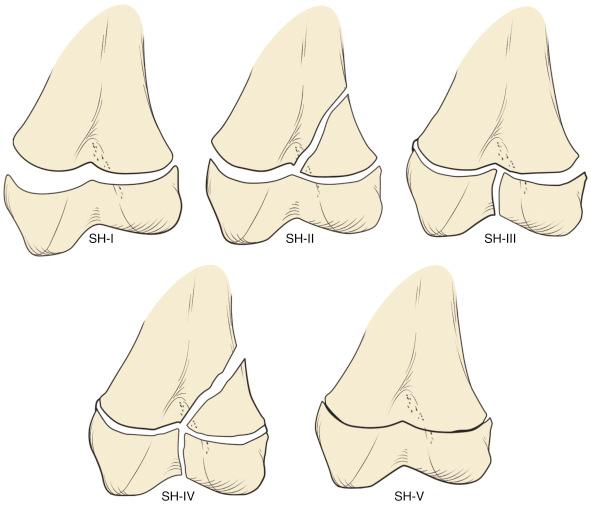
Coronal fractures of the femoral condyles—Hoffa fractures—have been described in children. Depending on the location of the fracture line, these injuries may be classified as type III Salter-Harris fractures, or they may be entirely intraepiphyseal ( Fig. 13.6 ).
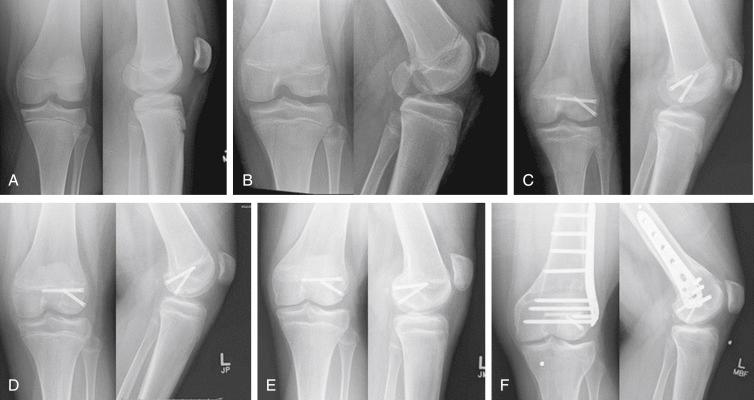
A careful neurovascular examination is required in all distal femoral physeal fractures but especially in hyperextension injuries. The presence and strength of the pedal pulses and the function of the common peroneal and posterior tibial nerves should be documented. An assessment of the ABI should be considered in any patients with a clinical examination concerning for vascular injury. If the clinical findings of acute ischemia are present—pallor, coolness, cyanosis, or delayed capillary refilling—reduction of the fracture should be attempted as soon as possible, as in ischemic distal femoral metaphyseal fracture. If vascularity is not restored after reduction, immediate vascular exploration is indicated. In the absence of an obviously ischemic limb, patients with any findings concerning for decreased perfusion or vascular injury should be carefully monitored for signs of late ischemia or compartment syndrome and may warrant advanced vascular imaging. As described for fractures of the distal femoral metaphysis, serial neurovascular examinations should be performed during the first few days following fracture so as not to miss a developing compartment syndrome or intimal tear with thrombosis.
After initial examination and providing any necessary emergent treatment, the injured extremity should be splinted in a position of comfort and elevated to the level of the heart.
Nonoperative treatment with a long leg cast is appropriate for nondisplaced Salter-Harris type I and II injuries. The duration of immobilization varies with the age of the patient. Spica cast immobilization can be considered for short, obese children or unreliable patients. Patients treated nonoperatively should be observed closely and have follow-up radiographs taken 5 to 7 days after initial treatment to identify and address any interval displacement.
Although nondisplaced type III and IV injuries can be treated with cast immobilization and close clinical follow-up, percutaneous fixation with pins or screws supplemented by cast immobilization is typically preferable to prevent physeal or articular incongruity. In fact, some authors advocate for operative fixation of all type III and IV fractures, as imaging modalities may underestimate intra-articular displacement. As such, Wall and May recommend a 3-cm medial or lateral parapatellar incision when treating these fractures, allowing direct palpation of the joint surface during reduction and fixation.
Surgical treatment is indicated for all displaced fractures of the distal femoral physis. Treatment options for this injury include closed reduction and percutaneous pin fixation followed by application of a long leg cast and open reduction and internal fixation.
Closed reduction and percutaneous fixation is recommended for displaced type I and II fractures and for nondisplaced type III and IV fractures.
The reduction technique varies depending on the displacement of the fracture. In general, the surgical assistant secures the proximal thigh while the surgeon accentuates the deformity, applies longitudinal traction, and ultimately reduces the distal fragment into the appropriate position. General anesthesia and muscle paralysis will help ensure that this reduction maneuver is performed with attention not to further damage the physis through forceful reduction. In instances in which the distal fragment is displaced anteriorly, the reduction maneuver may be performed with the patient placed in either the supine or prone position.
Internal fixation makes subsequent displacement less likely, allows the use of a long leg cast with a greater margin of safety, and avoids having to place the knee in an extreme position of flexion or extension to maintain the reduction. After the fracture is reduced under image intensifier control, smooth transphyseal pins are inserted retrograde in a crossed fashion for type I injuries and type II injuries with small metaphyseal fragments ( Fig. 13.7 ). The pins should cross above (not at) the physis and engage the metaphyseal cortices. The pins are bent to avoid migration. They may be bent and cut beneath the skin or percutaneously. They can alternatively be advanced to exit the skin proximally, proximal to the knee joint, where they can be bent and left percutaneously. Type II fractures with an adequately sized metaphyseal fragment on both AP and lateral views are best stabilized with all-metaphyseal cannulated screws ( Fig. 13.8 ). Type III fractures are best stabilized with all-epiphyseal pins or cannulated screws ( Fig. 13.9 ). Type IV fractures are stabilized with all-metaphyseal smooth pins or screws with supplementary all-epiphyseal fixation, if necessary ( Figs. 13.10 and 13.11 ).
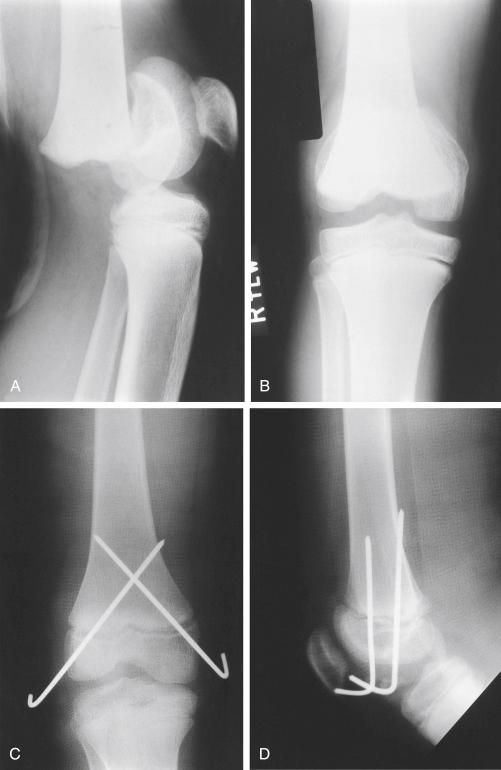
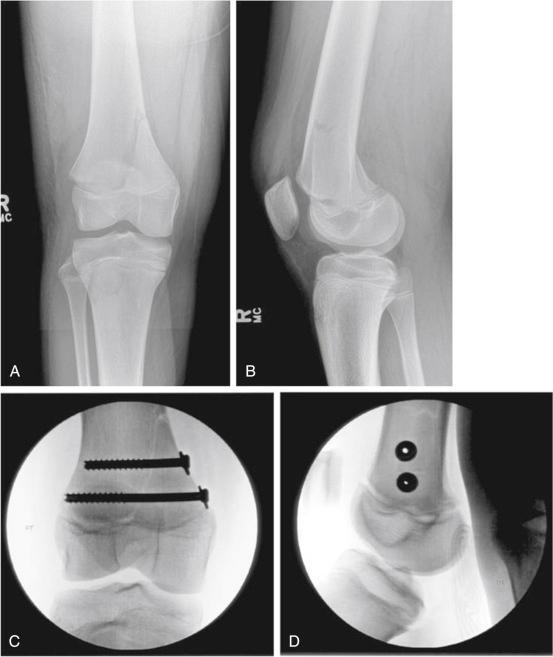

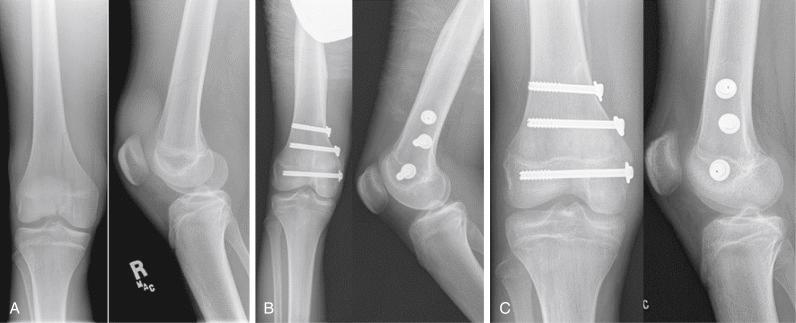
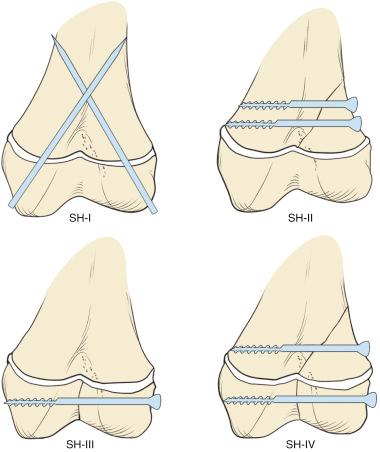
After fixation is achieved, the knee is brought through a full range of motion under fluoroscopy to confirm the stability of the construct. A long leg cast is applied with the knee immobilized in 20 to 30 degrees of flexion. Percutaneous pins should be removed at 4 weeks so that the risk of infection is reduced. Cast immobilization should continue for a total of 6 weeks but may require longer in older children.
Open reduction is indicated for all type I and II fractures that cannot be accurately reduced by closed methods or if an arterial injury has occurred at the time of fracture. If the epiphysis is displaced laterally, a medial approach provides visualization of any obstacles to reduction and avoids disruption of the intact lateral periosteal hinge. If the epiphysis is displaced medially, a lateral approach is recommended for similar reasons. A posterior approach should be used if arterial exploration is indicated. Once the fracture is reduced, fixation is achieved as described above.
Open reduction with internal fixation is further recommended for all displaced type III and IV fractures to restore congruity of the articular surface. Because type III and IV fractures are intra-articular, an approach that provides adequate visualization to both the articular surface and the physis or metaphysis is required.
Type III fractures are approached through an anteromedial or anterolateral arthrotomy, depending on the location of the vertical component of the fracture through the epiphysis. Alternatively, arthroscopically assisted reduction is a viable alternative to those surgeons with that skillset. Once accurate reduction is achieved, the fracture is stabilized with all-epiphyseal partially threaded cancellous screws placed across the fracture under image intensifier control ( Fig. 13.9 ).
For type IV fractures, the chosen approach should allow for visualization of the epiphyseal and metaphyseal fracture line. Once accurate reduction is achieved, the fracture is stabilized with one or two all-metaphyseal cancellous partially threaded screws. An all-epiphyseal screw is added only if adequate stability of the fracture cannot be achieved by fixation of the metaphyseal fragment alone.
Postoperative immobilization can be achieved with a long leg cast or knee immobilizer based on surgeon preference in addition to the patient’s age and perceived reliability. If secure fixation is achieved and a knee immobilizer is used for supplemental immobilization, early range of motion of the knee may be encouraged. Supplemental immobilization can be discontinued 6 weeks postoperatively, beginning a rehabilitation protocol focused on recovering knee range of motion. Weight-bearing should be avoided until radiographs confirm that the fracture is fully healed.
Open reduction and internal fixation is further indicated for coronal shear fractures. The fracture is exposed through a medial or lateral parapatellar approach, depending on which condyle is affected. After anatomic reduction, interfragmentary lag screws are placed through and buried beneath the articular cartilage without crossing the physis. Postoperatively, a long leg cast or brace is used. As with type III and type IV fractures, early range of motion of the knee may be encouraged, but weight-bearing should be avoided until radiographs confirm fracture healing.
Outcomes associated with fractures of the distal femoral physis are generally good. The patient should continue to be followed clinically and radiographically after fracture union to allow for early identification of growth disturbances.
Loss of initial reduction may occur in fractures treated by closed reduction and cast immobilization. Close clinical and radiological follow-up is essential in such cases to ensure early identification of any loss of reduction, allowing for surgical correction of the displacement. In addition, some patients may initially present with a displaced fracture several days after injury. Although evidence is generally lacking, the consensus of most authorities is that displaced type I and II fractures should not undergo manipulative reduction after 7 to 10 days for fear of causing further physeal injury. It is probably better to accept a malunion after this period of time and to allow the fracture to heal and remodel rather than performing a late open reduction. Depending on patient age and outcome, residual deformity can be addressed with an osteotomy or with guided growth. Unlike type I and II fractures, type III and IV fractures with late displacement should undergo open reduction and internal fixation to restore articular congruity.
The incidence of an associated compartment syndrome has been estimated to be approximately 1%. Volkmann ischemic contracture has been reported in two patients in a series of 151 distal femoral physeal fractures. Although the reported incidence of this complication is low, the consequences are often devastating. The importance of early recognition and prompt intervention in children who demonstrate the signs and symptoms of compartment syndrome cannot be overemphasized.
Associated peroneal nerve palsy has also been reported by Eid et al to be as high as 7.3%, resolving in all cases within 3 months of injury without the need for routine surgical exploration. However, in cases in which the neurologic deficit persists beyond 3 months, electromyographic testing should be considered, and further intervention may be warranted.
A number of authors have reported concomitant distal femoral physeal fractures and ligamentous injuries. Most often, the ligamentous injuries are not appreciated at the time the physeal injuries are treated. In these instances, laxity of the knee joint is discovered after the fracture has healed. Anterior laxity has been reported most frequently, followed by lateral and medial laxity. These reports emphasize the need for continued follow-up after fracture union as well as consideration of advanced imaging at the time of presentation.
Although the prognosis for a fracture of the distal femoral physis is generally good, growth arrest and angular deformity are more common than one might expect according to the Salter-Harris classification. A meta-analysis by Basener and colleagues reviewed 564 fractures involving the distal femoral physis. Overall, 52% of patients developed a growth disturbance. This complication occurred in 36% of type I fractures, 58% of type II fractures, 49% of type III fractures, and 64% of type IV fractures. Unexpectedly high rates of physeal disturbances following distal femoral physeal fractures may be associated with the large forces required to cause physeal separation at this site, especially in younger patients whose thicker periosteal and perichondrial sheaths typically provide greater stability.
Growth disturbances are more likely to occur in fractures that are initially displaced, in younger patients, 3133 and in those in which anatomic reduction is not achieved. Riseborough observed that fractures occurring in children with ages between 2 and 11 years were more likely to result in growth disturbances than similar fractures in adolescents, as they were typically a result of higher-energy trauma. The association between high-energy mechanism and growth disturbances has been corroborated by more recent series. Further, transphyseal fixation increases risk for growth disturbance. Although we advocate for transphyseal smooth cross-pin fixation in type I and some type II fractures, there is animal evidence that physeal bars may result from even small-diameter smooth pin fixation that crosses the physis.
Careful clinical evaluation is recommended at 6-month intervals after the injury to assess lower extremity alignment and leg length. Serial long leg alignment films should be obtained every 6 months as well. In addition to angular deformities and complete growth disturbances, partial inhibition of growth, or growth deceleration, can occur after distal femoral physeal injuries and can be identified with serial radiographic examinations. Isolated instances of growth stimulation after these fractures have also been reported. Therefore, these patients should be monitored until skeletal maturity. Multiple authors have reported following the configuration of Harris-Park growth lines to detect a growth disturbance early after fracture treatment. If these lines extend across the entire metaphysis in both planes and remained parallel to it, a growth arrest is unlikely.
Leg length inequalities estimated to result in less than a 2-cm differential at skeletal maturity require no treatment. If the estimated discrepancy at maturity is between 2 and 5 cm, an appropriately timed epiphysiodesis of the contralateral extremity may be indicated. For inequalities estimated at maturity to be more than 5 cm, lengthening should be considered.
Angular deformities may result from either malunion or partial growth arrest. Significant angular deformity caused by malunion may be managed by osteotomy or, when appropriate, by guided growth through hemiepiphysiodesis. Treatment options for a progressive angular deformity caused by a partial growth disturbance include osseous bridge resection, osteotomy, or completing the epiphysiodesis in the remaining portion of the physis. Osseous bridge resection may be considered for lesions involving less than 50% of the physis in children who have at least 2 years of growth remaining. Results are best if the osseous bar is located peripherally. The surgical incision is made either laterally or medially, depending on the location of the bar. The area of resection is determined preoperatively based on advanced imaging with either an MRI or CT scan. A high-speed burr is employed to resect the osseous bridge until normal physeal cartilage is visualized circumferentially within the defect. The defect is then packed with either autogenous fat or methyl methacrylate (Cranioplast) to prevent reformation of the osseous bridge. Small metal markers placed in the metaphysis and the epiphysis aid follow-up evaluation of growth resumption. If varus or valgus deformity of the distal end of the femur is greater than 20 degrees at the time of bridge resection, a distal femoral osteotomy should also be performed to realign the knee joint. Guided growth with hemiepiphysiodesis of the preserved half of the physis may be considered as an adjunct in lesser degrees of deformity in children with sufficient skeletal growth remaining.
An osteotomy with complete epiphysiodesis may be necessary when the bridge is too large to excise or in children who are approaching skeletal maturity.
Nonunion has been reported in coronal shear fractures involving the femoral epiphysis. These reports highlight the importance of early diagnosis and treatment of these uncommon injuries by open reduction and internal fixation.
An osteochondral fracture of the knee is most commonly seen in adolescent patients. It is often associated with patellar dislocation, being present in up to 75% of acute patellar dislocations in children and adolescents.
The etiology of these fractures is likely related to the unique structure of the cartilage-bone interface in the developing knee. Multiple authors have postulated that the pediatric population is most susceptible to these fractures because the calcified cartilage layer is immature. This results in a weakened cartilaginous-bone interface. One relatively recent histopathologic study concluded that adolescents were particularly susceptible to osteochondral fractures because of structural changes that occur in the anchoring region of the osteochondral junction during skeletal maturation. They demonstrated that fingers of compliant cartilage penetrate deep into the subchondral bone in immature tissue, providing a strong cartilaginous anchor. In mature tissue, articular cartilage is secured to the subchondral bone by a well-defined layer of calcified cartilage. During adolescence, the interdigitating fingers are replaced with a calcified matrix before the mature calcified cartilage layer is fully developed. This makes the adolescent more susceptible to failure in the osteochondral region.
Osteochondral fractures of the knee most often result from either a direct force exerted on a flexed knee or, more commonly, shearing forces associated with acute patellar dislocation. These injuries most commonly occur in adolescents. When associated with patellar dislocation, these fractures occur when the dislocated patella slides tangentially over the surface of the lateral femoral condyle. The fracture may occur during either the dislocation or relocation. Rorabeck and Bobechko estimated that osteochondral fractures occur in approximately 5% of all acute patellar dislocations occurring in children. Nietosvaara and colleagues found associated osteochondral fractures, either capsular avulsions or intra-articular loose bodies, in 28 of 72 children (39%) after an acute patellar dislocation. Stanitski and Paletta reported articular injuries in 34 of 48 older children and adolescents (71%) following acute patellar dislocation. More recently, Seeley and colleagues noted 46 osteochondral injuries in 122 children (38%) with acute patellar dislocation.
Become a Clinical Tree membership for Full access and enjoy Unlimited articles
If you are a member. Log in here